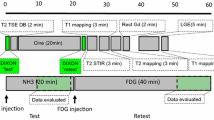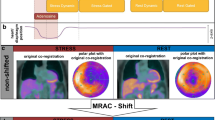Abstract
Background
The current study evaluated the usefulness of a belt technique for restricting respiratory motion of the heart and for improving image quality of 13N-ammonia myocardial PET/CT, and it assessed the tolerability of the belt technique in the clinical setting.
Methods
Myocardial 13N-ammonia PET/CT scanning was performed in 8 volunteers on Discovery PET/CT 690 with an optical respiratory motion tracking system. Emission scans were performed with and without an abdominal belt. The amplitude of left ventricular (LV) respiratory motion was measured on respiratory-gated PET images. The degree of erroneous decreases in regional myocardial uptake was visually assessed on ungated PET images using a 5-point scale (0 = normal, 1/2/3 = mild/moderate/severe decrease, 4 = defect). The tolerability of the belt technique was evaluated in 53 patients.
Results
All subjects tolerated the belt procedure. The amplitude of the LV respiratory motion decreased significantly with the belt (8.1 ± 7.1 vs 12.1 ± 6.1 mm, P = .0078). The belt significantly improved the image quality scores in the anterior (0.29 ± 0.81 vs 0.71 ± 1.04, P = .015) and inferior (0.33 ± 0.92 vs 1.04 ± 1.04, P < .0001) wall. No adverse events related to the belt technique were observed.
Conclusions
The belt technique restricts LV respiratory motion and improves the image quality of myocardial PET/CT, and it is well tolerated by patients.








Similar content being viewed by others
Abbreviations
- CT:
-
Computed tomography
- LV:
-
Left ventricular
- PET:
-
Positron emission tomography
- SPECT:
-
Single-photon emission computed tomography
References
Flechter M, Ghadri JR, Gebhard C, Fuchs TA, Pazhenkottil AP, Nkoulou RN, et al. Diagnostic value of 13N-ammonia myocardial perfusion PET: Added value of myocardial flow reserve. J Nucl Med 2012;53:1230-4.
Herzog BA, Husmann L, Valenta I, Gaemperli O, Siegrist PT, Tay FM, et al. Long-term prognostic value of 13N-ammonia myocardial perfusion positron emission tomography added value of coronary flow reserve. J Am Coll Cardiol 2009;54:150-6.
Chin BB, Nakamoto Y, Kraitchman DL, Marshall LT, Wahl R. PET-CT evaluation of 2-deoxy-2-[18F]fluoro-d-glucose myocardial uptake: Effect of respiratory motion. Mol Imaging Biol 2003;5:57.
Wells RG, Ruddy TD, DeKemp RA, DaSilva JN, Beanlands RS. Single-phase CT aligned to gated PET for respiratory motion correction in cardiac PET/CT. J Nucl Med 2010;51:1181.
Slomka PJ, Rudeaux M, Le Meunier L, et al. Dual-gated motion-frozen cardiac PET with Flurpiridaz F18. J Nucl Med 2015;56:1876-81.
Pourmoghaddas A, Klein R, deKemp RA, Wells RG. Respiratory phase alignment improves blood-flow quantification in Rb82 PET myocardial perfusion imaging. Med Phys 2013;40:022503. doi:10.1118/1.4788669.
Schleyer PJ, O’Doherty MJ, Barrington SF, Morton G, Marsden PK. Comparing approaches to correct for respiratory motion in NH3 PET-CT cardiac perfusion imaging. Nucl Med Commun 2013;34:1174-84.
Ishida M, Schuster A, Takase S, Morton G, Chiribiri A, Bigalke B, et al. Impact of an abdominal belt on breathing pattern and scan efficiency in whole-heart coronary magnetic resonance angiography: Comparison between the UK and Japan. J Cardiovasc Mag Reson 2011;13:71.
Nehmeh SA, Erdi YE, Pan T, Pevsner A, Rosenzweig KE, Yorke E, et al. Four dimensional (4D) PET/CT imaging of the thorax. Med Phys 2004;31:3179-86.
Nagel CC, Bosmans G, Dekker ALAJ, Ollers MC, De Ruysscher DKM, Lambin P, et al. Phased attenuation correction in respiration correlated computed tomography/positron emitted tomography. Med Phys 2006;33:1840-7.
Ponish F, Richter C, Just U, Enghardt W. Attenuation correction of four dimensional (4D) PET using phase-correlated 4D-computed tomography. Phys Med Biol 2008;53:N259-68.
Visvikis D, Barret O, Fryer TD, Lamare F, Turzo A, Bizais Y, et al. Evaluation of respiratory motion effects in comparison with other parameters affecting PET image quality. In: 2004 IEEE nuclear science symposium conference record, 16-22 October 2004, Rome, Italy, vol. 6, pp. 3668-3672.
Qiao F, Pan T, Chark JW, Mawlawi OR. A motion-incorporated reconstruction method for gated PET studies. Phys Med Biol 2006;51:3769-83.
Li T, Thornddyke B, Schreibmann E, Yang Y, Xing L. Model-based image reconstruction for four-dimensional PET. Med Phys 2006;33:1288.
Lamare F, Ledesma Carbayo MJ, Cresson T, Kontazakis G, Santos A, Le Rest CC, et al. List-mode-based reconstruction for respiratory motion correction in PET using non-rigid body transformations. Phys Med Biol 2007;52:5187-204.
Dawood M, Kosters T, Fieseler M, Buther F, Jiang X, Wubbeling F, et al. Motion correction in respiratory gated cardiac PET/CT using multi-scale optical flow. Med Image Comput Comput Assist Interv 2008;11:155-62.
Danias PG, Stuber M, Botnar RM, Kissinger KV, Edelman RR, Manning WJ. Relationship between motion of coronary arteries and diaphragm during free breathing: Lessons from real-time MR imaging. AJR Am J Roentgenol 1999;172:1061-5.
Martinez-Moller A, Zikic D, Botnar RM, Bundschuh RA, Howe W, Ziegler SI, et al. Dual cardiac-respiratory gated PET: Implementation and results from a feasibility study. Eur J Nucl Med Mol Imaging 2007;34:1447-54.
Bitarafan-Rajabi A, Rajabi H, Rastrou F, Yaghoobi N, Malek H, et al. Influence of respiratory motion correction on quantification of myocardial perfusion SPECT. J Nucl Cardiol 2015;22:1019-30.
Redgate S, Barber DC, Abdallah A-M, Wendy TB. Using a registration-based motion correction algorithm to correct for respiratory motion during myocardial perfusion imaging. Nucl Med Commun 2013;34:787-95.
Disclosure
The authors report no conflicts of interest to disclose.
Author information
Authors and Affiliations
Corresponding author
Additional information
See related editorial, doi:10.1007/s12350-016-0647-4.
Appendix
Appendix
Preliminary Assessment of Image Quality of the Second PET Scan Images
Prior to the study, a preliminary evaluation to investigate if sufficient image quality can be obtained by the second PET scan with acquisition time of 20 minutes, which was employed in the study protocol, was performed.
In this preliminary evaluation, 6 healthy volunteers (4 men, 2 women; mean age, 64 ± 2 years) who underwent 13N-ammonia myocardial perfusion PET imaging were included. The dose of 13N-ammonia and the PET scan protocol of the preliminary study were identical to those of the main study, with the exception that the abdominal belt technique was not applied during the scan. For the assessment of image quality, left ventricular (LV) short-axis ungated PET images of the first and second scans with slice thickness of 5 mm were reconstructed with CT attenuation correction. The image quality of the first and second PET scans was evaluated on a 5-point scale (score 5 = excellent image quality without erroneously decreased uptake in the myocardium, score 4 = good image quality but mild erroneously decreased uptake, score 3 = acceptable image quality with moderate erroneously decreased uptake, score 2 = insufficient image quality due to severe erroneously decreased uptake, score 1 = very poor image quality) by consensus of two experienced radiologists.
There were no significant differences in image quality between the first and second PET scan images (3.7 ± 0.8 vs 3.7 ± 0.8, P = ns).
Based on the results of this preliminary assessment, it was concluded that sufficient image quality can be obtained by the second PET scan with acquisition time of 20 minutes.
Rights and permissions
About this article
Cite this article
Ichikawa, Y., Tomita, Y., Ishida, M. et al. Usefulness of abdominal belt for restricting respiratory cardiac motion and improving image quality in myocardial perfusion PET. J. Nucl. Cardiol. 25, 407–415 (2018). https://doi.org/10.1007/s12350-016-0623-z
Received:
Accepted:
Published:
Issue Date:
DOI: https://doi.org/10.1007/s12350-016-0623-z




